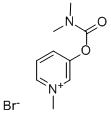Description
Pyridostigmine is an inhibitor of acetylcholinesterase (AChE) and butyrylcholinesterase (BChE; IC
50s = 0.35 and 1 μM, respectively, for the human enzymes). Pyridostigmine (10 μM) reduces decreases in AChE activity induced by the organophosphate pesticides diisopropyl fluorophosphate, chlorpyrifos-oxon, diazinon-oxon, paraoxon, and malaoxon in isolated bovine red blood cells. It also reduces soman-induced membrane depolarization and decreases in AChE activity in isolated human muscle bundles in a concentration-dependent manner. Pyridostigmine (3 mg/kg per day for four weeks) prevents tachycardia and increases in sympathetic tone in mice following myocardial infarction induced by left coronary artery ligation. Formulations containing pyridostigmine have been used in the treatment of myasthenia gravis and as neuromuscular protective agents against organophosphate poisoning.
Chemical Properties
White Solid
Uses
Cholinergic, used in the treatment of myasthenia gravis, and is a pre-exposure antidote to chemical warfare agents.
Definition
ChEBI: Pyridostigmine bromide is a pyridinium salt.
brand name
Mestinon (Valeant); Regonol (Sandoz).
General Description
Pyridostigmine bromide,3-hydroxy-1-methylpyridinium bromide dimethylcarbamateor pyridostigmine bromide (Mestinon), occurs as a white, hygroscopic,crystalline powder with an agreeable, characteristicodor. It is freely soluble in water, alcohol, and chloroform.
Pyridostigmine bromide is about one fifth as toxic asneostigmine. It appears to function in a manner similar tothat of neostigmine and is the most widely used anticholinesteraseagent for treating myasthenia gravis. Theliver enzymes and plasma cholinesterase metabolize thedrug. The principal metabolite is 3-hydroxy-N-methylpyridinium.Orally administered pyridostigmine has a half-lifeof 90 minutes and a duration of action of between 3 and6 hours.
Biochem/physiol Actions
Acetylcholinesterase inhibitor.
Clinical Use
Myasthenia gravis
Drug interactions
Potentially hazardous interactions with other drugs
Aminoglycosides, clindamycin and polymyxins
antagonise effects of pyridostigmine.
Metabolism
Pyridostigmine undergoes hydrolysis by cholinesterases
and is also metabolised in the liver. It appears that 75%
of the plasma clearance of pyridostigmine depends on
renal function. 3-Hydroxy-N-methylpyridinium has been
identified as one of the 3 metabolites isolated from the
urine. Pyridostigmine is excreted mainly in the urine as
unchanged drug and metabolites.





